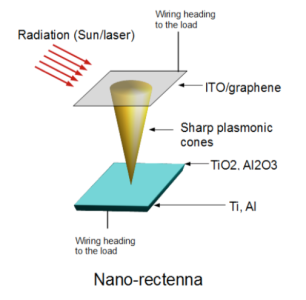Solar Rectennas – Nanosized Rectenna for Solar Cells

Motivation:
To provide a proof-of-concept demonstration of light rectification in a nano-rectenna as an alternative energy conversation process to semiconductor solar cells based on the photovoltaic effect. For space this alternative energy conversion process could enable applications under different environmental conditions (e.g. temperature ranges, radiation) and offer the advantage of higher theoretical conversion efficiency.
Methodology:
To provide a proof-of-concept demonstration of rectennas working at high frequencies through the development of:
i) simulation tools and fabrication procedures for nano-antennas - plasmonic nano-cones - suitable for light coupling at visible wavelengths;
ii) a versatile setup based on customized Atomic Force Microscope (AFM) to perform opto-electronic experiments of the assembled nano-rectennas.
In particular, a plasmonic scanning probe for AFM, serving the role of antenna, was designed to couple efficiently with the incoming radiation in a specific frequency range, whereas an insulator deposited over a metal together with the metal antenna, serves as diode. This constituted a point-contact Metal-Insulator-Metal tunnelling diode geometry in which
asymmetry in terms of materials as well as shape was incorporated. The nano-rectenna was tested in a setup, which was specifically built and customized to perform opto-electronic experiments.
Results:
• Successfully developed a simulation framework for nano-cone antennas suitable for light coupling in the visible wavelengths (400-800 nm) using both FIT and FEM based simulations. The simulation provided optical and thermal characteristics of the structure to be tested in experiments.
• Successfully fabricated nano-cone antennas using focused ion beam lithography and integrated them in a customized atomic force microscope setup for optoelectronics experiments. The experimental results clearly reveal the role of the tunnelling diode materials, insulator thickness and surface roughness, nano-cone antenna diameter, polarization and illumination power in achieving high frequency optical rectification.
• Introduced an up-scaling method from the proof-of-concept design by forming an array of nano-rectennas which can rectify light at same time. These results suggest the fabrication and up-scaling potential of this approach for a space as well as terrestrial application. Introduced multi-spectral operation strategies for a device sensitive to the full solar spectrum.
• Obtained improved conversion efficiencies with respect to the state-of-the-art literature in the subject. Optimisation potential via characterization of geometries and materials.
